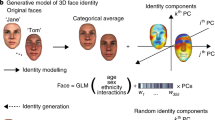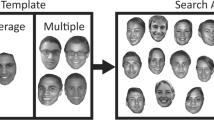Abstract
Witnesses and victims of serious crime are often required to construct a facial composite from their memory, a visual likeness of a suspect’s face. The traditional method is for them to select individual facial features to build a face, but often these images are of poor quality. We have developed a new method whereby witnesses repeatedly select instances from an array of complete faces and a composite is evolved over time by searching a face model built using Principal Components Analysis. While past research suggests that the new approach is superior, performance is far from ideal. In the current research, face models are built which match a witness’s description of a target. It is found that such ‘tailored’ models promote better quality composites, presumably due to a more effective search, and also that smaller models may be even better. The work has implications for researchers who are using statistical modelling techniques for recognising faces.




Similar content being viewed by others
References
Annesley J, Leung VL, Colombo A, Orwell J, Velastin SA (2006) Fusion of multiple features for identity estimation. IEE conference on crime and security. IET, London, pp 534–539
Burton AM, Jenkins R, Hancock PJB, White D (2005) Robust representations for face recognition: the power of averages. Cogn Psychol 51(3):256–284
Davies GM, Shepherd J, Shepherd J, Flin R, Ellis H (1986) Training skills in police photofit operators. Policing 2:35–46
Davies GM, van der Willik P, Morrison LJ (2000) Facial composite production: a comparison of mechanical and computer-driven systems. J Appl Psychol 85(1):119–124
Ellis H, Shepherd J, Davies GM (1979) Identification of familiar and unfamiliar faces from internal and external features: some implications for theories of face recognition. Perception 8:431–439
Frowd CD (2002) EvoFIT: a holistic, evolutionary facial imaging system. PhD thesis, University of Stirling (unpublished)
Frowd CD, Hancock PJB, Carson D (2004) EvoFIT: a holistic, evolutionary facial imaging technique for creating composites. ACM Trans Appl Psychol (TAP) 1:1–21
Frowd CD, Carson D, Ness H, Richardson J, Morrison L, McLanaghan S, Hancock PJB (2005a) A forensically valid comparison of facial composite systems. Psychol Crime Law 11(1):33–52
Frowd CD, Carson D, Ness H, McQuiston D, Richardson J, Baldwin H, Hancock PJB (2005b) Contemporary composite techniques: the impact of a forensically-relevant target delay. Leg Criminol Psychol 10:63–81
Frowd CD, Bruce V, McIntyre A, Ross D, Hancock PJB (2006a) Adding holistic dimensions to a facial composite system. In: Proceedings of the seventh international conference on automatic face and gesture recognition, Los Alamitos, pp 183–188
Frowd CD, Bruce V, Plenderleith Y, Hancock PJB (2006b) Improving target identification using pairs of composite faces constructed by the same person. IEE conference on crime and security. IET, London, pp 386–395
Frowd CD, Bruce V, McIntyre A, Hancock PJB (2007a) The relative importance of external and internal features of facial composites. Br J Psychol 98(1):61–77
Frowd CD, Bruce V, Ross D, McIntyre A, Hancock PJB (2007b) An application of caricature: how to improve the recognition of facial composites. Vis Cogn 15(8):1–31
Frowd CD, Bruce V, Ness H, Bowie L, Thomson-Bogner C, Paterson J, McIntyre A, Hancock PJB (2007c) Parallel approaches to composite production. Ergonomics 50(4):562–585
Geiselman RE, Fisher RP, MacKinnon DP, Holland HL (1986) Eyewitness memory enhancement with the cognitive interview. Am J Psychol 99:385–401
Gibson SJ, Solomon CJ, Pallares-Bejarano A (2003) Synthesis of photographic quality facial composites using evolutionary algorithms. In: Harvey R, Bangham JA (eds) Proceedings of the British machine vision conference, pp 221–230
Hancock PJB (2000) Evolving faces from principal components. Behav Res Methods Instrum Comput 32(2):327–333
Hancock PJB, Burton AM, Bruce V (1996) Face processing: human perception and principal components analysis. Mem Cogn 24:26–40
Hancock PJB, Bruce V, Burton AM (1997) Testing principal component representations for faces. In: Bullinaria JA, Glasspool DW, Houghton G (eds) Proceedings of fourth neural computation and psychology workshop. Springer, London, pp 84–97
Hancock PJB, Bruce V, Burton AM (2000) Recognition of unfamiliar faces. Trends Cogn Sci 4–9:330–337
Jain AK, Dass SC, Nandakumar K (2004) Soft biometric traits for personal recognition systems. In: Proceedings of international conference on biometric authentication, Hong Kong
Kirby M, Sirovich L (1990) Application of the Karhunen–Loeve procedure for characterization of human faces. IEEE Trans Pattern Anal Mach Intell 12:103–108
Mitchell M (1996) An introduction to genetic algorithms. MIT, London
O’Toole AJ, Abdi H, Deffenbacher KA, Valentin D (1993) Low dimensional representation of faces in high dimensions of the space. J Opt Soc Am A 10:405–410
Phillips PJ, Grother P, Michaelis RJ, Blackburn DM, Tabassi E, Bone JM (2003) Face recognition vendor test 2002. Evaluation report NISTIR6965
Prince SJD, Elder JH, Hou Y, Oleviskiy Y (2006) Towards face recognition at a distance. IEE conference on crime and security. IET, London, pp 570–575
Shepherd JW (1986) An interactive computer system for retrieving faces. In: Ellis HD, Jeeves MA, Newcombe F, Young A (eds) Aspects of face processing. Martinus Nijhoff, Dordrecht, pp 398–409
Sirovich L, Kirby M (1987) Low-dimensional procedure for the characterization of human faces. J Opt Soc Am 4:519–524
Tanaka JW, Sengco JA (1997) Features and their configuration in face recognition. Mem Cogn 25(5):583–592
Tredoux C, Nunez DT, da Costa L, Rosenthal Y (1999) Face reconstruction using a configural, eigenface-based composite system. In: Presented at SARMAC III, Boulder, Colorado
Troje NF, Vetter T (1996) Representation of human faces. Technical report. Max-Planck-Institut, Tubingen
Acknowledgments
The work was funded by a grant from the Engineering and Physical Sciences Research Council, EP/C522893/1, and from Crime Solutions at the University of Central Lancashire, Preston, UK. We would like to thank Martin’s Newsagent, Winstanley, Wigan, and Wigan Cricket Club, Parsons Walk, Wigan, for allowing participant recruitment for Experiments 2 and 3, respectively.
Author information
Authors and Affiliations
Corresponding author
Appendix: EvoFIT screen shot
Appendix: EvoFIT screen shot

Rights and permissions
About this article
Cite this article
Frowd, C., Bruce, V., Pitchford, M. et al. Evolving the memory of a criminal’s face: methods to search a face space more effectively. Soft Comput 14, 81–90 (2010). https://doi.org/10.1007/s00500-008-0391-z
Published:
Issue Date:
DOI: https://doi.org/10.1007/s00500-008-0391-z




